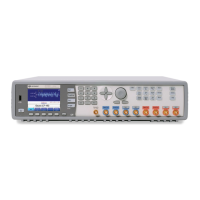This command controls the format of data transfer for the :DIG:DATA
command. . In the following description, MLbit stands for a multi-level bit (a
bit value that has either 2, 3 or 4 levels).
The following values are possible:
1 – This is the default format and should be used in most cases.
Data is sent as a string of ASCII 1’s and 0’s (or ASCII ‘0’, ‘1’ and ‘2’ for
3-level patterns, or ASCII ‘0’,’1’,’2’ and ‘3’ for 4-level patterns).
Only the least significant bit (2-level patterns) or two bits (3- and 4-level
patterns) are used to define a single MLbit.
4 – The data is sent as a string HEX characters. With this format, the
amount
of data to be transmitted is reduced amount, but the binary block data
still contains printable characters (which is needed for some
programming environments). For 2-level patterns, bits 3 through 0
of each symbol are used to define 4 MLbits. For 3- and 4-level patterns,
bits 3&2 and 1&0 are used to define 2 MLbits.
8 – The data is sent as a string of 8-bit ASCII characters. All 8 bits are used.
This format provides maximum packing density, but the binary data
block might contain non-printable characters.
For 2-level patterns, bits 7 through 0 define one MLbit each;
For 3- and 4-level patterns, bits 7&6, 5&4, 3&2 and 1&0 define one
MLbit each.
Data is used from left to right and within one byte from MSB to LSB.

